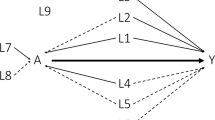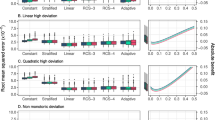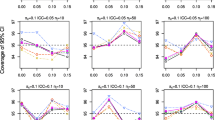Abstract
Applied health services researchers often use methods that address observed confounding in attempts to estimate causal treatment effects. In prior work, vector-based kernel weighting (VBKW) was shown to minimize bias and maximize efficiency compared to other propensity-score based methods in categorical treatment settings. Entropy balancing (EB) has been shown to outperform other weighting and matching schemes in binary treatment settings. We extend EB to a categorical treatment setting and compare the bias and efficiency of estimates obtained through EB and VBKW in analytic scenarios likely to be encountered by applied researchers. To do so, we followed a simulation design with a known data generating process, allowing variation in the functional form for treatment assignment, sampling distribution, treatment effect heterogeneity, and coefficient magnitude for determining treatment assignment. We investigated 210 unique analytic scenarios using Monte-Carlo simulations with 1000 replications and examined 9 unique estimands. Our results indicate that EB consistently outperformed VBKW on measures of efficiency and bias. EB had lower median absolute mean relative bias (0.007 vs 0.05), smaller median absolute error (0.003 vs 0.031), smaller root mean squared error (0.003 vs 0.048), and a smaller interquartile range of the estimate (0.003 vs 0.060). Despite better performance, we found that as baseline imbalance in covariates (as measured by standardized mean differences in prognostic scores) increased, the likelihood of the EB algorithm failing to converge also increased. We provide guidance to researchers on choosing the most appropriate strategy in applied settings considering the potential tradeoffs.

Similar content being viewed by others
References
Garrido, M.M., Kelley, A.S., Paris, J., et al.: Methods for constructing and assessing propensity scores. Health Serv. Res. 49(5), 1701–1720 (2014). https://doi.org/10.1111/1475-6773.12182
Garrido, M.M., Lum, J., Pizer, S.D.: Vector-based kernel weighting: a simple estimator for improving precision and bias of average treatment effects in multiple treatment settings. Stat. Med. 40(5), 1204–1223 (2021). https://doi.org/10.1002/sim.8836
Greifer, N.: WeightIt: weighting for covariate balance in observational studies. Published online May 23, 2023. Accessed May 24, 2023. https://cran.r-project.org/web/packages/WeightIt/index.html
Hainmueller, J.: Entropy balancing for causal effects: a multivariate reweighting method to produce balanced samples in observational studies. Polit. Anal. 20(1), 25–46 (2012). https://doi.org/10.1093/pan/mpr025
Hainmueller, J., Xu, Y.. EBALANCE: stata module to perform entropy reweighting to create balanced samples. Statistical Software Components. Published online January 30, 2015. Accessed February 21, 2023. https://ideas.repec.org//c/boc/bocode/s457326.html
Holgado-Tello, F.P., Chacón-Moscoso, S., Barbero-García, I., Vila-Abad, E.: Polychoric versus Pearson correlations in exploratory and confirmatory factor analysis of ordinal variables. Qual. Quant. 44(1), 153–166 (2010). https://doi.org/10.1007/s11135-008-9190-y
LaPar, D.J., Bhamidipati, C.M., Mery, C.M., et al.: Primary payer status affects mortality for major surgical operations. Ann. Surg. 252(3), 544–551 (2010). https://doi.org/10.1097/SLA.0b013e3181e8fd75
Li, Y., Li, L.: Propensity score analysis methods with balancing constraints: a Monte Carlo study. Stat. Methods Med. Res. 30(4), 1119–1142 (2021). https://doi.org/10.1177/0962280220983512
Lum, J., Garrido, M.: VBKW: stata module to perform vector-based Kernel weighting. Published online February 4, 2022. Accessed February 28, 2023. https://econpapers.repec.org/software/bocbocode/s459019.htm
McNamee, R.: Confounding and confounders. Occup. Environ. Med. 60(3), 227–234 (2003). https://doi.org/10.1136/oem.60.3.227
Perreira, K.M., Sloan, F.A.: Excess alcohol consumption and health outcomes: a 6-year follow-up of men over age 50 from the health and retirement study. Addiction 97(3), 301–310 (2002). https://doi.org/10.1046/j.1360-0443.2002.00067.x
Rassen, J.A., Shelat, A.A., Franklin, J.M., Glynn, R.J., Solomon, D.H., Schneeweiss, S.: Matching by propensity score in cohort studies with three treatment groups. Epidemiology 24(3), 401–409 (2013). https://doi.org/10.1097/EDE.0b013e318289dedf
Rosenzweig, S.J., Pfail, J.L., Katims, A.B., et al.: The impact of discharge location on outcomes following radical cystectomy. Urol. Oncol. Semin. Orig. Investig. 40(2), 63.e1-63.e8 (2022). https://doi.org/10.1016/j.urolonc.2021.07.020
Santacatterina, M., Bottai, M.: Optimal probability weights for inference with constrained precision. J. Am. Stat. Assoc. 113(523), 983–991 (2018). https://doi.org/10.1080/01621459.2017.1375932
Setoguchi, S., Schneeweiss, S., Brookhart, M.A., Glynn, R.J., Cook, E.F.: Evaluating uses of data mining techniques in propensity score estimation: a simulation study. Pharmacoepidemiol. Drug Saf. 17(6), 546–555 (2008). https://doi.org/10.1002/pds.1555
Stuart, E.A., Lee, B.K., Leacy, F.P.: Prognostic score–based balance measures for propensity score methods in comparative effectiveness research. J. Clin. Epidemiol. 66(80), S84-S90.e1 (2013). https://doi.org/10.1016/j.jclinepi.2013.01.013
Tübbicke, S.: Entropy balancing for continuous treatments. J. Econom. Methods. 11(1), 71–89 (2022). https://doi.org/10.1515/jem-2021-0002
Zhao, Q., Percival, D.: Entropy balancing is doubly robust. J. Causal Inference. 5(1), 20160010 (2017). https://doi.org/10.1515/jci-2016-0010
Zubizarreta, J.R.: Stable weights that balance covariates for estimation with incomplete outcome data. J. Am. Stat. Assoc. 110(511), 910–922 (2015). https://doi.org/10.1080/01621459.2015.1023805
Funding
This work was supported by VA HSR&D IIR Grant No. 16-140 (PI: Garrido).
Author information
Authors and Affiliations
Contributions
Y.F. conducted statistical analysis. Y.F. and M.G. wrote the main manuscript text, evaluated methods, and prepared figures. J.L. and M.G. developed one of the comparison methods. All authors reviewed the manuscript and helped to develop the ideas and implementation.
Corresponding author
Ethics declarations
Conflict of interest
The authors declare no competing interests.
Ethical Approval
This work does not represent the views of the U.S. federal government, the Department of Veterans Affairs, or the Department of Health and Human Services.
Additional information
Publisher's Note
Springer Nature remains neutral with regard to jurisdictional claims in published maps and institutional affiliations.
Supplementary Information
Below is the link to the electronic supplementary material.
Rights and permissions
Springer Nature or its licensor (e.g. a society or other partner) holds exclusive rights to this article under a publishing agreement with the author(s) or other rightsholder(s); author self-archiving of the accepted manuscript version of this article is solely governed by the terms of such publishing agreement and applicable law.
About this article
Cite this article
Feyman, Y., Lum, J., Asfaw, D. et al. Entropy balancing versus vector-based kernel weighting for causal inference in categorical treatment settings. Health Serv Outcomes Res Method (2024). https://doi.org/10.1007/s10742-024-00331-8
Received:
Accepted:
Published:
DOI: https://doi.org/10.1007/s10742-024-00331-8




